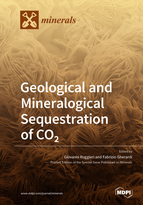Geological and Mineralogical Sequestration of CO2
A special issue of Minerals (ISSN 2075-163X).
Deadline for manuscript submissions: closed (31 July 2019) | Viewed by 41915
Special Issue Editors
Interests: fluid inclusions; stable isotopes; CO2 mineral sequestration; geothermal resources; hydrothermal mineralization; fluid-rock interaction experiments; ore deposits
Special Issues, Collections and Topics in MDPI journals
Special Issue Information
Dear Colleagues,
The rapid increase of concentrations of greenhouse gases, anthropologically-generated (primarily CO2) in the atmosphere, is responsible for global warming and ocean acidification. Carbon capture and storage (CCS) techniques have been proposed and developed to contrast the rise of CO2 in atmosphere. One of the technological solutions is the long-term storage of CO2 into appropriate geological formations, such as deep saline formations and depleted oil and gas reservoirs. A potential alternative to CO2 geological storage is CO2 mineral sequestration through carbonation (ex situ and in situ), leading to the permanent and safe storage of CO2.
This Special Issue aims to collect articles covering various aspects of recent scientific advances of CO2 storage, including characterization of storage formations and cap-rocks and their behavior during CO2 injection, storage modelling studies for test design, test site results and environmental monitoring, numerical modelling of geochemical-mineralogical reactions and CO2 flow, studies of natural analogs of CO2 storage and CO2 mineral sequestration, and experimental investigations to better understand long-term geological storage and carbonation processes.
Dr. Giovanni Ruggieri
Dr. Fabrizio Gherardi
Guest Editors
Manuscript Submission Information
Manuscripts should be submitted online at www.mdpi.com by registering and logging in to this website. Once you are registered, click here to go to the submission form. Manuscripts can be submitted until the deadline. All submissions that pass pre-check are peer-reviewed. Accepted papers will be published continuously in the journal (as soon as accepted) and will be listed together on the special issue website. Research articles, review articles as well as short communications are invited. For planned papers, a title and short abstract (about 100 words) can be sent to the Editorial Office for announcement on this website.
Submitted manuscripts should not have been published previously, nor be under consideration for publication elsewhere (except conference proceedings papers). All manuscripts are thoroughly refereed through a single-blind peer-review process. A guide for authors and other relevant information for submission of manuscripts is available on the Instructions for Authors page. Minerals is an international peer-reviewed open access monthly journal published by MDPI.
Please visit the Instructions for Authors page before submitting a manuscript. The Article Processing Charge (APC) for publication in this open access journal is 2400 CHF (Swiss Francs). Submitted papers should be well formatted and use good English. Authors may use MDPI's English editing service prior to publication or during author revisions.
Keywords
- Geological CO2 storage
- CO2 storage test-site
- Mineral carbonation
- Numerical modeling
- Fluid-rock interaction experiments
- Natural analogues of CO2 storage







